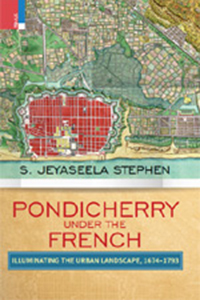
Pondicherry under the French: Illuminating the Urban Landscape, 1674-1793
AUTHOR : S. Jeyaseela Stephen
| HB ₹1695 . $79.95 . ₤64.95 |
||
INFORMATION
- EDITOR : S. Jeyaseela Stephen
- HB ISBN : 978-93-86552-92-1
- Year : 2018
- Extent : 690 pp.
- Discount available on checkout
- Usually dispatched within 3 to 5 working days.
Tagore
| HB ₹ 995 . $ . ₤ |
PB ₹ . $ . ₤ |
|
| POD ₹ . $ . ₤ |
e-Book ₹ . $ . ₤ |
INFORMATION
- AUTHOR –
- ISBN – 978-93-84082-78-9
- Year – 2016
- Extent: 400 + 40 coloured illustrations
- 10% discount + free shipping
- Usually dispatched within 3 to 5 working days.
Pondicherry under the French: Illuminating the Urban Landscape, 1674-1793 explores how the town of Pondicherry developed as the epicentre of the French presence in India, becoming a major centre of Company administration. It evaluates the relative significance of inland trade and overseas commerce in generating mercantile wealth by examining the volume and value of commercial transactions and the interactions between the French, Tamils, Telugus, Gujaratis and the Armenians. This resulted in the urbanization of the town, which in turn dramatically and radically changed its skyline. The collective composition of the external agencies, cross-cultural connections and knowledge networks led to new forms of art, architecture and culture with the French attempting to convert the urban reality of Pondicherry into a smart city. As the French presence evolved from a trading company into a colonial state, Pondicherry, called ‘The Pearl of French India’, became one of the most advanced cities in the world in terms of governance, politics and global linkages.
The Author
S. Jeyaseela Stephen is Directeur, Institut pour études Indo-Européennes and was Professor of Maritime History at Visva-Bharati University, Santiniketan from 2001 to 2013. His publications include Oceanscapes: Tamil Textiles in the Early Modern World (2014); A Meeting of the Minds: European and Tamil Encounters in Modern Sciences, 1507-1857 (2016); From Anrique Anriquez to Louis Savinien Dupuis: The Tamil Grammar and Dictionary Quest (2017); and Missioner Tamil Written and Printed in Pondicherry: Literature and Louis Savinien Dupuis, 1841-73 (2017).
As a global figure, Tagore transcends the boundaries of language and reaches out to people distant both in time and space. His art took inspiration from contemporary Western trends and became a powerful means to connect with people beyond Bengal. Word, image, song, and text were his tools of communication, as also his extraordinary presence in a sartorial garb of his own design. A littérateur in many genres, the impact of his work was determined both by the material he presented, and by its simultaneously local and global contexts. Now, when his international reputation has spanned over more than a hundred years, it is important to revisit the sites of Tagore’s eminence, and ask to what extent he was a ‘living text’ in the century that witnessed him as a global intellectual.
Accordingly, this volume investigates how Tagore’s writings and art are linked to the metalinguistic domains of the psychological, medical and mythical; how he was received in various cultures outside India; how his art was determined by individual circumstances and global aspirations; and how he acted as an inspiration to his contemporaries and subsequent generations including modern Indian writers and artists.
The Editor
Imre Bangha studied in Budapest and Santiniketan and at present is Associate Professor of Hindi at the University of Oxford. He has published books and essays in English, Hindi, and Hungarian on literature in Brajbhasha and other forms of old Hindi and has also prepared Hungarian translations from various South Asian languages. His work on the international reception of Bengali culture includes Rabindranath Tagore: Hundred Years of Global Reception (2014, co-edited with M. Kämpchen) and Hungry Tiger: Encounter between India and Central Europe (2007).




